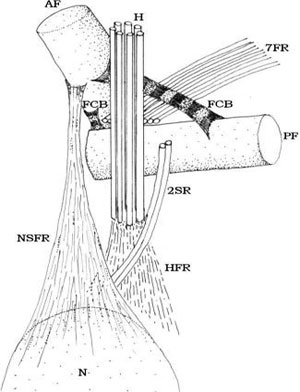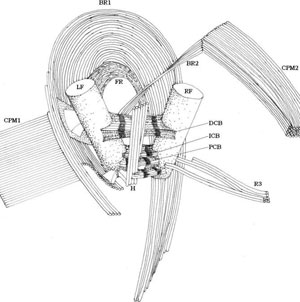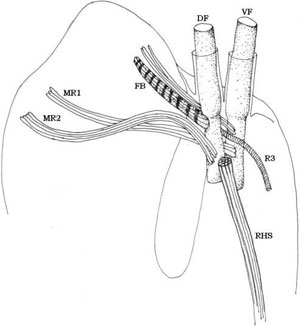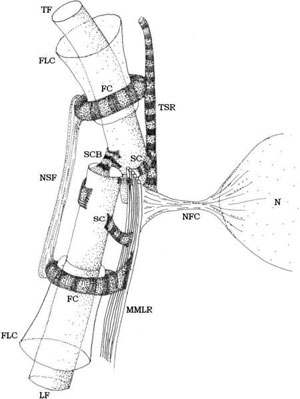Haptophyta
In the Haptophyta there are different types of flagellar roots. Members of the order Pavlovales, such as Pavlova and Diacronema, possess a fibrous root, non-striated, which extends from the base of the anterior flagellum, and passes into the cell along the inner face of the nucleus, becoming progressively wider. In some species, another fibrous root originates at the base of the haptonema. Two
microtubular roots extend from the base of the posterior flagellum: a seven-stranded root which
runs under the periplast, and a two-stranded root arising almost at right angles to the seven-stranded
root, running inside the cell opposite to the haptonema. Fibrous connecting bands are present
between the basal bodies (Figure 2.51). In the algae of the order Isochrysidales, such as Pleurochrysis, the structure of the flagellar root system is more complex. Three main microtubular roots are associated with the two basal bodies, two broad roots, no. 1 and no. 2, arising near the left flagellum, and a smaller root, no. 3, arising near the right flagellum. Root no. 1 extends from the basal body up towards the cell apex and then curves backwards to run inside the cell. A fibrous root is associated with root no. 1. Closely packed microtubules organized in a bundle branch off perpendicularly from both root no. 1 and root no. 2. The basal bodies are connected to each other by distal, intermediate, and proximal connecting bands. Accessory connecting bands link the haptonema to the basal bodies and the left basal body to the broad microtubular root no. 1 (Figure 2.52).

FIGURE 2.51 Root system of Pavlovales (Haptophyta). AF, anterior flagellum; PF, posterior flagellum; NSFR, nonstriated fibrous root; H, haptonema; HFR, haptonema fibrous root; 2SR, two-stranded root; 7SR, seven-stranded root; FCB, fibrous connecting band; and N, nucleus.

FIGURE 2.52 Root system of Pleurochrysis sp. (Haptophyta). LF, left flagellum; RF, right flagellum; H, haptonema; BR1 and BR2, broad microtubular roots; FR, fibrous root; R3, small microtubule root; CPM1, CPM2, closely packed microtubules; DCB, distal connecting band; ICB, intermediate connecting band; and PCB, proximal connecting band.
Cryptophyta

FIGURE 2.53 Root system of Cryptophyta. DF, dorsal flagellum; VF, ventral flagellum; RHS, rhizostyle; FB, fibrous band; MR1 and MR2, microtubular roots; and R3, root.
The flagellar roots of these algae include two characteristic components, the rhizostyle and the compound rootlet. The rhizostyle is a posteriorly directed microtubular structure. It originates alongside the basal body of the dorsal flagellum, extends deep into the cell, parallel to the gullet, behind the layer of trichocysts, and ends in the posterior part of the cell. On the way, it runs through a groove in the nuclear surface. In many cryptomonads, such as Chilomonas, each of the rhizostyle microtubule bears a wing-like lamellar projection. The compound rootlet consists of a cross-banded fibrous band and microtubular roots. The fibrous band originates from the basal bodies of the dorsal flagellum, but perpendicularly to the rhizostyle.
A microtubular root arises near the rhizostyle and passes between the basal bodies in close association with the fibrous band, a second microtubular root extends dorso-laterally in a curved path, and a third root, which can be very short, originates near the rhizostyle and extends anteriorly. In addition to this rootlet, a conspicuous twelve-stranded microtubular root is present in Chilomonas, together with a mitochondrion-associated lamella root, while a delicated cross-banded anchoring fiber connecting one of the basal bodies to the ventral groove is present in Cryptomonas. The striated components of the root system have been shown
to contain the contractile protein centrin (Figure 2.53).

FIGURE 2.53 Root system of Cryptophyta. DF, dorsal flagellum; VF, ventral flagellum; RHS, rhizostyle; FB, fibrous band; MR1 and MR2, microtubular roots; and R3, root.
Dinophyta

FIGURE 2.54 Root system of Dinophyta. TF, transverse flagellum; LF, longitudinal flagellum; SCB, striated connective band; MMLR, multimembered longitudinal root; TSR, transverse striated root; SC, striated connectives; NFC, nuclear fibrous connective; N, nucleus; FC, fibrous collars; FC, flagellar canals; and NSF, nonstriated fiber.
The root apparatus of these algae is quite complex for number and appearance of ancillary structures
associated to the microtubular roots, and for the spatial relationship between roots and other
cell organelles. Minor features can be considered specie-specific, whereas major components are
common to almost all the dinoflagellates. The longitudinal basal body and the transverse basal
body are interconnected by a small striated connective band. A multimembered microtubular
root, the longitudinal root originates on left side of the longitudinal basal body and continues posteriorly along the sulcus. A cross-striated fibrous root, the transverse striated root, emanates from the left side of the transverse basal body and runs along the transverse flagellar canal and the cingulum. Striated connectives link the transverse striated root to both the longitudinal root and the
longitudinal basal body, and the proximal portion of the longitudinal basal body to the longitudinal
root.
The most distinct connective is a large electron-opaque fiber termed the nuclear fibrous connective, which links the proximal parts of the longitudinal root, the transverse striated root, and
the transverse and longitudinal basal bodies with the nucleus. Fibrous rings with cross-striations,
called fibrous collars, encircle the flagellar canals, the longitudinal striated collar less conspicuous than the transverse striated collar. A non-striated fiber interconnects the two collars. The fibrous elements of this complex root apparatus are likely to contain centrin (Figure 2.54).

FIGURE 2.54 Root system of Dinophyta. TF, transverse flagellum; LF, longitudinal flagellum; SCB, striated connective band; MMLR, multimembered longitudinal root; TSR, transverse striated root; SC, striated connectives; NFC, nuclear fibrous connective; N, nucleus; FC, fibrous collars; FC, flagellar canals; and NSF, nonstriated fiber.










